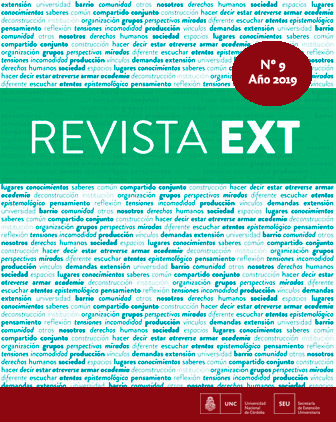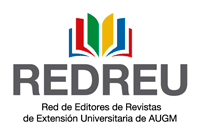Society and University in Extension Construction
Keywords:
Society, University, Construction, Outreach, Dialogic relationshipAbstract
The social function of university is based on the relationship between teaching, research and community outreach. Extension policy, which is part of education policy, should aim at meeting the demands of a complex and globalized society in the collaborative construction of knowledge and its extension. It is essential that there is a dialogical, communicational and dynamic relationship between both. The relationships between university and society involve their organizations and institutions, as well as different types of appraisal around university, knowledge and the relationship established between it and the different sectors of society involved. It is worth mentioning that the notion of university outreach is closely related to how university defines itself and how it conceives its relationship with society. The analysis of these characteristic components makes it possible to visualize the different levels and directions assumed by the university-society interaction. All this entails the need for participating teachers with ethical and social commitment to build bridges between both institutions as a whole, enriching the dialogue and knowledge exchange. In our view, the classroom is the most appropriate place to generate the deepest and more meaningful actions regarding university-community engagement, it being a relevant and necessary process. We consider that the classroom constitutes the genesis, the first space for building up the dialogic relationship and the community outreach function.
Downloads
References
ÁVILA, Olga Silvia (2008): Estudios de extensión en humanidades: Hacer y pensar con otros en la universidad pública .Revista e+e. Estudios de Extensión en Humanidades – volumen 1 – año 1 – 2008 – Facultad de Filosofía y Humanidades – UNC.
DECLARACIÓN DE LA CONFERENCIA REGIONAL DE LA EDUCACIÓN SUPERIOR EN AMÉRICA LATINA Y EL CARIBE (2008). Cartagena de Indias. http://www.fvet.uba.ar/institucional/ Declaracion.pdf. 25/07/13.
DECLARACIÓN DE LA CONFERENCIA MUNDIAL DE LA EDUCACIÓN SUPERIOR. UNESCO. París 2009. http://www.me.gov.ar/spu/documentos/Declaracion_conferencia_ Mundial de_Educacion_Superior_2009.pdf . 25/07/13.
ESCOTET, Miguel Ángel (1996). Universidad y Devenir. Lugar Editorial .Buenos Aires.
FREIRE, Paulo (1991): ¿Extensión o comunicación?. Ed. Siglo XXI, 13ª ed. en español. México.
GEZMET, Sandra (2010). La vinculación universidad-sociedad. Modelos de extensión y características de las interacciones.
GONZÁLEZ FERNÁNDEZ-LARREA, Mercedes y GONZÁLEZ GONZÁLEZ, Gil Ramón (2003). “Universidad, Sociedad y extensión universitaria: apuntes para un análisis”. http://www.sappiens.com/castellano/articulos.nsf/Educadores/Universidad, Sociedad_y_extensi%C3%B3n_universitaria:_apuntes_para_un_an%C3%A1lisis./1441CF5BE17A6CC5C1256DD30047B14B!opendocument. 25/07/13.
GONZÁLEZ FERNÁNDEZ-LARREA, Mercedes y GONZÁLEZ GONZÁLEZ, Gil Ramón (2003). “Extensión universitaria: principales tendencias en su evolución y desarrollo”. En: Revista Cubana de Educación Superior; XXI 11.
JORNADA NACIONAL DE EXTENSIÓN UNIVERSITARIA ( 2005) La Plata y en la JORNADA NACIONAL DE EXTENSIÓN UNIVERSITARIA (2005), Mendoza.
SERNA ALCÁNTARA, Gonzalo Aquiles (2004). Modelos de extensión universitaria en México. En: Revista de la Educación Superior, XXXIII.
SERNA ALCÁNTARA, Gonzalo Aquiles (2007). Misión social y modelos de extensión universitaria: del entusiasmo al desdén. En: Revista Iberoamericana de Educación, 43. http://www.rieoei.org/deloslectores/1662Aquiles.pdf. 25/07/13.
Downloads
Published
Issue
Section
License
Aquellos autores/as que tengan publicaciones con esta revista, aceptan los términos siguientes:
- Los autores/as conservarán sus derechos de autor y garantizarán a la revista el derecho de primera publicación de su obra, el cuál estará simultáneamente sujeto a la Licencia de reconocimiento de Creative Commons que permite a terceros compartir la obra siempre que se indique su autor y su primera publicación esta revista.
- Los autores/as podrán adoptar otros acuerdos de licencia no exclusiva de distribución de la versión de la obra publicada (p. ej.: depositarla en un archivo telemático institucional o publicarla en un volumen monográfico) siempre que se indique la publicación inicial en esta revista.
- Se permite y recomienda a los autores/as difundir su obra a través de Internet (p. ej.: en archivos telemáticos institucionales o en su página web) después del proceso de publicación, lo cual puede producir intercambios interesantes y aumentar las citas de la obra publicada. (Véase El efecto del acceso abierto).





